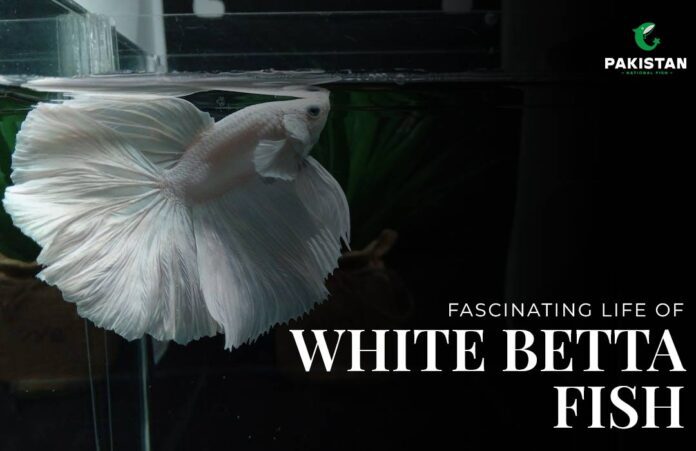With its beautiful look and appealing behaviour, the white betta fish provides aquarium lovers with a one-of-a-kind and satisfying experience. Understanding the life of betta fish, its native environment, temperament, and care requirements will help you ensure a healthy and happy existence. Whether you are a seasoned fish keeper or a newbie, the timeless beauty of the white betta will improve your aquarium experiences.
There are different beautiful types of betta fish including koi betta fish, and black betta but the opalescent white opal betta is amazing to see. These pure white fish have an opalescent gloss that occasionally casts a slightly pink colour, adding a captivating dimension to their look. Many white opal betta keepers are asking if their fish is gradually turning a very light pink.

Physical Features of White Betta Fish
White Betta fish, also known as Betta splendens, are admired for their striking and elegant appearance. Here are some of their notable physical features:
- Body: White bettas have snowy white bodies and fins. Some may exhibit a slight shimmering effect, reflecting shades of blue or pink under certain lighting circumstances. They have long, flowing fins and a tail that varies in shape and size depending on the type.
- Size: Adult white bettas average 2.5 to 3 inches in length. They weigh only a few grams, and females are often smaller and less bright than males.
- Facial Features: White Bettas have prominent, expressive eyes that can range from dark to light hues, sometimes showing a hint of the iridescence seen in their bodies. Their facial features are delicate and well-defined, adding to their overall aesthetic appeal.
Reasons Why White Betta Color Changes?
While this colour shift may be a pleasant surprise for some, in others, your betta’s turning white may cause anxiety. Here are a few common explanations:
- Stress: Being stressed might cause your Betta fish to lose colour. Bettas, like people, experience stress when their surroundings are unsuitable for living, which usually manifests physically as them going white or discoloured.
- Water Effectiveness: Insufficient water changes or high levels of ammonia, nitrite, and nitrate in the water might cause your betta’s colour to fade.
- Injury: Some bettas turn white as a result of aggressive tank mates, injuries from aquarium filters, or cuts from objects that are sharp in the aquarium.
- Viral Infections: If your betta is turning white and exhibiting symptoms such as fatigue, loss of appetite, and scraping against objects, it may be suffering from ich, a parasitic skin illness.
The Breeding Process of White Betta Fish
- Transfer the female Betta to the breeding aquarium via a partition or floating container, allowing the pair to observe each other without making physical contact.
- The male will create a bubble nest on the water’s surface. When ready, release the female.
- The pair will perform a courtship dance, with the male encircling the female and fertilizing the eggs as she discharges them.
- The male collects the eggs and places them in the bubble nest. Remove the female after hatching to avoid aggressiveness.
Tips for Managing White Betta's Health
Having a healthy habitat for your betta is essential to let their brilliant colours come through. Here are some useful tips:
- Maintaining Water Quality: Changing your betta’s water regularly and monitoring for toxic substances such as ammonia, nitrite, and nitrate can help keep her colours bright.
- Decrease stress: Decrease stress by creating a tranquil atmosphere with appropriate tank mates, a soft filter, and a fully submerged water heater to keep the temperature perfect.
- Check for Injuries and Diseases: Check for symptoms of injury or disease regularly and administer appropriate treatment as soon as possible.
Aquarium for White Betta Fish
Here are key aspects to consider when setting up an aquarium for a White Betta:
- Size: A fish aquarium of 5 gallons is suggested for a single betta, while larger tanks are preferable for their overall health.
- Water Parameters: Maintain a temperature of 76-82°F, a pH of 6.5 to 7.5, and soft to moderately hard water.
- Filtration: Use a moderate filter to prevent powerful currents from stressing the fish. Regular water changes are required to preserve water quality.
- Lighting: Moderate illumination replicates their natural environment and encourages healthy plant development.
- Plants: Plants, whether live or silk, provide hidden spaces and help to relieve stress. Avoiding plastic plants, as they might rip delicate fins.
- Substrate: To prevent harm, use smooth gravel or sand. Avoid using sharp embellishments.
Conclusion
The white betta fish, with its opalescent beauty and engaging behaviour, offers a captivating experience for both novice and seasoned aquarium enthusiasts. Understanding their native environment, temperament, and care requirements is crucial for ensuring a healthy and fulfilling life for these elegant creatures. With proper tank setup, regular maintenance, and mindful attention to their health, the timeless allure of the white betta will continue to enhance your aquarium experience, making it a rewarding and visually stunning hobby.


